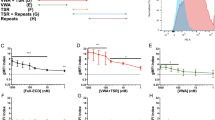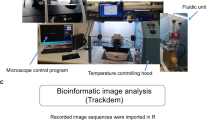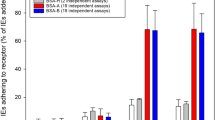Abstract
THE primary event in the pathogenesis of severe malaria in Plasmodium falciparum infection is thought fo be adherence of trophozoite- and schizont-infected erythrocytes to capillary endothelium1, a process called sequestration. Identifying the endothelial molecules used as receptors is an essential step in understanding this disease process. Recent work implicates the membrane glycoprotein CD36 (platelet glycoprotein IV; refs 2–5) and the multi-functional glycoprotein thrombospondin6 as receptors. Although CD36 has a widespread distribution on microvas-cular endothelium7, it may not be expressed on all capillary beds where sequestration occurs, especially in the brain8. The role of thrombospondin in cell adhesion,in vitro or in vivo, is less certain4,9. We have noticed that some parasites bind to human umbilical-vein endothelial cells independently of CD36 or thrombospondin. To screen for alternative receptors, we have developed a novel cell-adhesion assay using transfected COS cells, which confirms that CD36 is a cell-adhesion receptor. In addition, we find that an endothelial-binding line of P. falciparum binds to COS cells transfected with a complementary DNA encoding intercellular adhesion molecule-1. As this molecule is widely distributed on capillaries and is inducible10, this finding may be relevant to the pathogenesis of severe malaria.
This is a preview of subscription content, access via your institution
Access options
Subscribe to this journal
Receive 51 print issues and online access
$199.00 per year
only $3.90 per issue
Buy this article
- Purchase on Springer Link
- Instant access to full article PDF
Prices may be subject to local taxes which are calculated during checkout
Similar content being viewed by others
References
MacPherson, G. G., Warrell, M. J., White, M. J., Looareesuwan, S. & Warrell, D. A. Am. J. Path. 119, 385–401 (1985).
Ockenhouse, C., Tandon, N. N., Magowan, C., Jamieson, G. A. & Chulay, J. D. Science 243, 1469–1471 (1989).
Barnwell, J. W., Ockenhouse, C. F. & Knowles, D. M. J. Immun. 135, 3494–3497 (1985).
Panton, L. J., Leech, J. H., Miller, L. H. & Howard, R. J. Infect. Immunity 55, 2754–2758 (1987).
Ockenhouse, C. F. & Chulay, J. D. J. infect. Dis. 157, 584–588 (1988).
Roberts, D. D. et al. Nature 318, 64–66 (1985).
Knowles, D. M. et al. J. Immun. 132, 2170–2173 (1984).
Aikawa, M. Am. J. trop. Med. Hyg. 39, 3–10 (1988).
Sherwood, J. A. et al. Am. J. trop. Med. Hyg. 40, 119–127 (1989).
Dustin, M. L., Rothlein, R., Bhan, A. K., Dinarello, C. A. & Springer, T, A. J. Immun. 137, 245–254 (1986).
Marsh, K., Marsh, V. M., Brown, J., Whittle, H. C. & Greenwood, B. M. Expl Parasit. 65, 202–208 (1988).
Seed, B. & Aruffo, A. Proc. natn. Acad. Sci. U.S.A. 84, 3365–3369 (1987).
Simmons, D., Makgoba, M. W. & Seed, B. Nature 331, 624–627 (1988).
Schulz, T. F., Mitterer, M., Neumayer, H. P., Vogetseder, W. & Dierich, M. P. Eur. J. Immun. 18, 1253–1258 (1988).
Von dem Borne, A. E. G. Kr. et al. in Leucocyte Typing III 748–755 (Oxford University Press, 1987).
Udeinya, I. J., Schmidt, J. A., Aikawa, M., Miller, L. H. & Green, I. Science 213, 555–557 (1981).
Schmidt, J. A. et al. J. clin. Invest. 70, 379–386 (1982).
Marlin, S. D. & Springer, T. A. Cell 51, 813–819 (1987).
Dougherty, G. J., Murdoch, S. & Hogg, N. Eur. J. Immun. 18, 35–39 (1988).
Boyd, A. W., Wawryk, S. O., Burns, G. F. & Fecondo, J. W. Proc. natn. Acad. Sci. U.S.A. 85, 3095–3099 (1988).
Pober, J. S. et al. J. Immun. 137, 1893–1896 (1986).
Cotran, R. S. Am. J. Path. 129, 407–413 (1987).
Grau, G. E. et al. N. Engl. J. Med. 320, 1586–1591 (1989).
Trager, W. & Jensen, J. B. Science 193, 673–675 (1976).
Haynes, J. D., Diggs, C. L., Hines, F. A. & Desjardins, R. E. Nature 263, 767–769 (1979).
Jaffe, E. A., Nachman, R. L., Becker, C. G. & Minick, C. R. J. clin. Invest. 52, 2745–2756 (1973).
Oquendo, P., Hundt, E., Lawler, J. & Seed, B. Cell 58, 95–101 (1989).
Author information
Authors and Affiliations
Rights and permissions
About this article
Cite this article
Berendt, A., Simmons, D., Tansey, J. et al. Intercellular adhesion molecule-1 is an endothelial cell adhesion receptor for Plasmodium falciparum. Nature 341, 57–59 (1989). https://doi.org/10.1038/341057a0
Received:
Accepted:
Issue Date:
DOI: https://doi.org/10.1038/341057a0
This article is cited by
-
Profiles of global mutations in the human intercellular adhesion molecule-1 (ICAM-1) shed light on population-specific malaria susceptibility
BMC Genomics (2023)
-
Refining the transcriptome of the human malaria parasite Plasmodium falciparum using amplification-free RNA-seq
BMC Genomics (2020)
-
Binding of human serum proteins to Plasmodium falciparum-infected erythrocytes and its association with malaria clinical presentation
Malaria Journal (2020)
-
In vitro selection for adhesion of Plasmodium falciparum-infected erythrocytes to ABO antigens does not affect PfEMP1 and RIFIN expression
Scientific Reports (2020)
-
Multiplexed quantitative proteomics provides mechanistic cues for malaria severity and complexity
Communications Biology (2020)
Comments
By submitting a comment you agree to abide by our Terms and Community Guidelines. If you find something abusive or that does not comply with our terms or guidelines please flag it as inappropriate.



